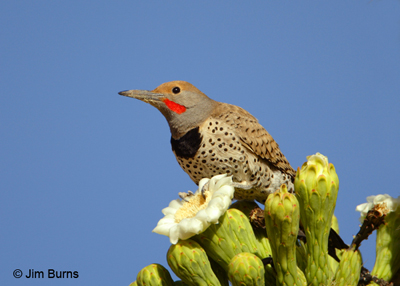
We have three woodpecker species in the neighborhood, all of which use our yard periodically. The busy, boisterous Gilas are the most frequent, coming to suet and the Saguaro blooms daily, and a few years back they raised a family in our front yard Saguaro. The Ladder-backed pair are a recent addition to the area. We have yet to figure out the attraction for them of urban life miles from any desert wash, but a few times each week we’ll hear their soft, staccato drumming on the utility pole out back. We’ve yet to see them at the suet, so they may be intimidated by the slightly larger, more aggressive thrashers and towhees.
The flickers are the main attraction, though to our chagrin we’ve never seen them give a passing glance to the enticing holes in our tall front Saguaro. Even in a family celebrated for unusual evolutionary adaptations, the flickers as a group are exceptional. They consume more ants than any other North American bird species and so, though vertical creatures while excavating their homes, they alone among woodpeckers spend most of their foraging time on the ground in horizontal posture.
Because they are ant specialists, flickers have taken the especially long woodpecker tongue to a developmental extreme and are capable of extending this wonderful tool fully five inches outside the bill when probing anthills. And because desert ants are not as arboreal as those in other habitats, Gildeds are seen in vertical posture even less than their flicker congeners and presumably have the longest tongue in the woodpecker tribe.
The male in the backyard dust was soon joined by his mate which proceeded to mimic his every move. They were of course, “anting,” which many species of birds do to control feather mites and other insect pests. Thus, not only are ants a food item, but they are also crushed and their fluid, which contains formic acid, is then rubbed into the feathers of the head and the undersides of the wings and tail. Call it what you will, deodorizing, debugging, but anting is the bird equivalent of the shower which you take, hopefully every day in Arizona’s hot climate. Strangely enough, however, not all individuals in an anting species engage in this activity. It is a learned behavior and not instinctive.
Last week, from ant discovery to post-ant preening, our Gilded Flicker pair spent fully ten minutes at their disinfection routine, then flew off exchanging their single, piercing, long-distance contact note—“Kleeear!” We hope we’ll be seeing the whole family, young of the year included, in the yard soon. It’s interesting to think any humans would be thankful for ants in their yard. Now if we could just figure out how to advertise our Saguaro cavities in flickereze.